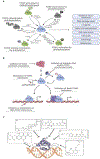FOXO transcription factors as therapeutic targets in human diseases
- PMID: 36280450
- PMCID: PMC12194985
- DOI: 10.1016/j.tips.2022.09.010
FOXO transcription factors as therapeutic targets in human diseases
Abstract
Forkhead box (FOX)O proteins are transcription factors (TFs) with four members in mammals designated FOXO1, FOXO3, FOXO4, and FOXO6. FOXO TFs play a pivotal role in the cellular adaptation to diverse stress conditions. FOXO proteins act as context-dependent tumor suppressors and their dysregulation has been implicated in several age-related diseases. FOXO3 has been established as a major gene for human longevity. Accordingly, FOXO proteins have emerged as potential targets for the therapeutic development of drugs and geroprotectors. In this review, we provide an overview of the most recent advances in our understanding of FOXO regulation and function in various pathological conditions. We discuss strategies targeting FOXOs directly or by the modulation of upstream regulators, shedding light on the most promising intervention points. We also reveal the most relevant clinical indications and discuss the potential, trends, and challenges of modulating FOXO activity for therapeutic purposes.
Keywords: FOXO transcription factors; aging; cancer; cardiovascular and neurodegenerative diseases; diabetes; drugs and geroprotectors.
Copyright © 2022 Elsevier Ltd. All rights reserved.
Conflict of interest statement
Declaration of interests W.L. is cofounder of Refoxy Pharmaceuticals GmbH, Berlin and is required by his institution to state so in his publications.
Figures




Similar articles
-
Forkhead box O proteins in chondrocyte aging and diseases.J Orthop Translat. 2025 Aug 10;54:167-179. doi: 10.1016/j.jot.2025.07.011. eCollection 2025 Sep. J Orthop Translat. 2025. PMID: 40822516 Free PMC article. Review.
-
Systemic pharmacological treatments for chronic plaque psoriasis: a network meta-analysis.Cochrane Database Syst Rev. 2021 Apr 19;4(4):CD011535. doi: 10.1002/14651858.CD011535.pub4. Cochrane Database Syst Rev. 2021. Update in: Cochrane Database Syst Rev. 2022 May 23;5:CD011535. doi: 10.1002/14651858.CD011535.pub5. PMID: 33871055 Free PMC article. Updated.
-
The link of FOXO1 and FOXO4 transcription factors to development of the lens.Dev Dyn. 2025 Jul;254(7):829-852. doi: 10.1002/dvdy.766. Epub 2025 Jan 11. Dev Dyn. 2025. PMID: 39797725 Free PMC article.
-
Systemic pharmacological treatments for chronic plaque psoriasis: a network meta-analysis.Cochrane Database Syst Rev. 2017 Dec 22;12(12):CD011535. doi: 10.1002/14651858.CD011535.pub2. Cochrane Database Syst Rev. 2017. Update in: Cochrane Database Syst Rev. 2020 Jan 9;1:CD011535. doi: 10.1002/14651858.CD011535.pub3. PMID: 29271481 Free PMC article. Updated.
-
Antidepressants for pain management in adults with chronic pain: a network meta-analysis.Health Technol Assess. 2024 Oct;28(62):1-155. doi: 10.3310/MKRT2948. Health Technol Assess. 2024. PMID: 39367772 Free PMC article.
Cited by
-
FBXO22 promotes osteosarcoma progression via regulation of FOXO1 for ubiquitination and degradation.J Cell Mol Med. 2024 Aug;28(16):e70021. doi: 10.1111/jcmm.70021. J Cell Mol Med. 2024. PMID: 39153212 Free PMC article.
-
Radiation-induced upregulation of FGL1 promotes esophageal squamous cell carcinoma metastasis via IMPDH1.BMC Cancer. 2024 May 3;24(1):557. doi: 10.1186/s12885-024-12313-7. BMC Cancer. 2024. PMID: 38702629 Free PMC article.
-
Identification of a novel FOXO3‑associated prognostic model in hepatocellular carcinoma.Oncol Lett. 2025 Mar 13;29(5):230. doi: 10.3892/ol.2025.14976. eCollection 2025 May. Oncol Lett. 2025. PMID: 40114746 Free PMC article.
-
Antioxidant Vitamins Attenuate Glyphosate-Induced Development of Type-2 Diabetes Through the Activation of Glycogen Synthase Kinase-3 β and Forkhead Box Protein O-1 in the Liver of Adult Male Rats.Cureus. 2023 Dec 25;15(12):e51088. doi: 10.7759/cureus.51088. eCollection 2023 Dec. Cureus. 2023. PMID: 38274944 Free PMC article.
-
Nucleolar Protein 56 Deficiency in Zebrafish Leads to Developmental Abnormalities and Anemia via p53 and JAK2-STAT3 Signaling.Biology (Basel). 2023 Mar 31;12(4):538. doi: 10.3390/biology12040538. Biology (Basel). 2023. PMID: 37106740 Free PMC article.
References
-
- Link W (2019) Introduction to FOXO Biology. Methods Mol Biol 1890, 1–9 - PubMed
Publication types
MeSH terms
Substances
Grants and funding
LinkOut - more resources
Full Text Sources
Research Materials
Miscellaneous

